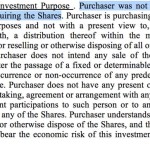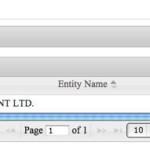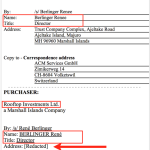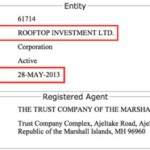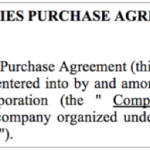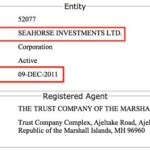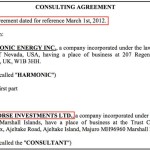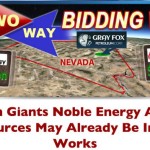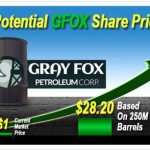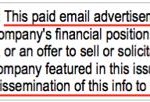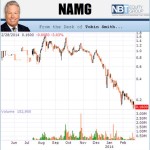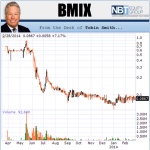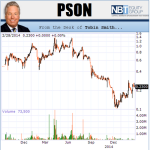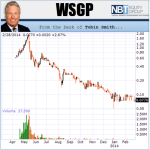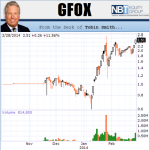Gray Fox Petroleum: A Promoted Stock At Risk For A Trading Halt …
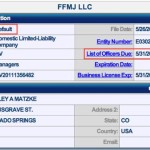
(Editor’s Note: This article covers a stock trading at less than $1 per share and/or with less than a $100 million market cap. Please be aware of the risks associated with these stocks.)
The Fraud Research Institute has completed its investigation into Gray Fox Petroleum, Inc. (OTCQB:GFOX) and holds a very strong opinion that since its inception, this public entity has been cultivated by stock promoters for the sole purpose of acquiring dirt-cheap shares and liquidating them at artificially inflated prices.
As we recently have witnessed, the stocks most frequently suspended from trading by the Securities and Exchange Commission seem to be heavily promoted penny stocks that own few assets aside from intangibles such as oil-and-gas lease agreements or property-purchase agreements. Some examples of those stocks:
Centor Energy, Inc. (OTC:CNTO)Nevada Gold Corp. (OTC:NVGC)Sovereign Lithium Inc. (OTC:SLCO)Norstra Energy Inc. (OTC:NORX)Southern USA Resources Inc. (OTC:SUSA)Polar Petroleum Corp. (OTC:POLR)Guar Global Ltd. (OTC:GGBL)ARX Gold Corp. (OTC:DUCP)Far Vista Petroleum (OTC:FVSTA)
We are of the opinion that for several reasons which are outlined in this report, GFOX is at risk of an SEC trading halt. Even if the stock is not halted, it most certainly will collapse once the stock promotion campaign ends and shares revert to their intrinsic value, which probably is less than $0.05 per share. We fully expect shares of GFOX to drop by 40-60 percent very soon, and in the long term, we expect shares to decline by 90-99 percent from current prices.
Highlights
- A lease purchase agreement with FFMJ, LLC is highly questionable, because the Nevada Secretary of State considered FFMJ, LLC to be in default at the time the agreement was signed.
- David Lubin, the attorney who assisted in the filing of the Company’s S-1 registration statement, also assisted two promoted penny stocks which eventually were halted by the SEC, including Biozoom, Inc. (OTC:BIZM).
- GFOX boasts an $85-million market cap, but operations are very limited and their primary asset consists of an oil-and-gas lease acquired for $250,000.
- The company has zero employees besides its 25-year old president & CEO.
- The company entered into six share purchase agreements with Rooftop Investment Ltd. We have reason to believe that all six contain at least one material misrepresentation.
- An offshore entity’s name is misspelled in all GFOX filings, the director of that entity has spelled his own name differently in separate SEC filings, and the corporate address for the offshore entity suspiciously has been redacted.
- There is a possibility of illegal, unregistered shares entering the marketplace because of an unjustified reliance on an exemption from registration, which reminds us of the BIZM debacle.
- An offshore financier of GFOX has participated in several dubious penny stock dealings, one of which was suspended by the SEC.
- The promotional advertisements featuring GFOX are incredibly deceptive, omit material information about the company, and appear to violate the Federal Trade Commission’s truth-in-advertising rules.
The Company’s headquarters is a virtual office in Dallas, TX, owned by Regus, and we have attempted to contact them via telephone for over one week and have been unable to get a response from their investor relations team. An email sent to [email protected] has also gone unanswered.
Company’s History
Gray Fox Petroleum Corp. (OTCQB:GFOX) originally was incorporated in Nevada as Viatech Corporation on Sept. 22, 2011. The company’s founder and sole officer at that time was Viatcheslav Gelshteyn, who was issued 7 million shares at a price of $0.001/share. The original business plan was to provide 3D rendering, architectural animation, and visualization services.
On May 25, 2012, with the help of David Lubin, the company filed its S-1 registration statement. That statement became effective on Sept. 12, 2012. As part of the statement, the company raised $20,200 by issuing 2,020,000 shares at a cost of $0.01/share.
Approximately one year after GFOX filed its registration statement, the founder sold his 7 million shares to Lawrence Pemble for $50,000. At the time, Pemble was a 25-year old residing in the United Kingdom and working for East African Gold PLC. Shortly after Pemble purchased the 7 million shares, he canceled 4.7 million of them, executed an 8-for-1 forward split, and changed the company’s name to Gray Fox Petroleum Corporation.
By June 2013, after the issuance of the founder’s shares, the S-1 capital raise, Pemble’s 4.7-million share cancellation, and the 8-for-1 forward split, the capital structure for Gray Fox Petroleum looked like this:
Shares Authorized
75,000,000 shares
Shares Outstanding
34,560,000 shares
Lawrence Pemble
18,400,000 shares (restricted)
S-1 Capital Raise ($20,200 @ $0.01/share)
16,160,000 shares
(free-trading)
About Gray Fox Petroleum
On July 5, 2013, Gray Fox Petroleum purchased 22 separate oil-and-gas leases from FFMJ, LLC for a price of $250,000. GFOX maintains a 100-percent working interest and an 82-percent revenue interest in the 32,723-acre prospect located in the Butte Valley Oil Play Region of North Central Nevada.
This lease purchase agreement marked GFOX’s entrance into the oil-and-natural-gas industry, but we must question the validity of the transaction. The agreement was dated July 5, 2013, but according to a Nevada Secretary of State business entity search, FFMJ, LLC already was in default at that time. Therefore, we question whether FFMJ, LLC was able to transact business and execute the lease purchase agreement with Gray Fox Petroleum.
Gray Fox Petroleum Corp. is a “going concern” company, with no revenues and zero employees besides Pemble, its 25-year old president. So far during its exploration phase, the company has accumulated a deficit of $557,555. GFOX’s balance sheet lists $29,084 cash and equivalents as of Dec. 31, 2013. Despite atrocious financials and such minimal operations to date, Pemble took $311,099 in salary for the nine months ending Dec. 31, 2013.
The company’s most recent quarterly report, released on Jan. 24, 2014, clearly states that Gray Fox Petroleum is a shell company, as defined by Rule 12b-2 of the Exchange Act.
Between July 17, 2013 and Feb. 18, 2014, the company entered into six separate securities purchase agreements with Rooftop Investment Ltd., issuing an aggregate 1,130,000 shares to the investor for total proceeds of $680,000 ($0.60 per share). We will discuss these purchase agreements in much greater detail in a later section, but they consist of the following:
DATE
# SHARES PURCHASED
PROCEEDS
PURCHASE
PRICE
Feb. 18, 2014
50,000
$100,000
$2.00/share
Jan. 16, 2014
80,000
$80,000
$1.00/share
Nov. 11, 2013
100,000
$100,000
$1.00/share
Oct. 15, 2013
100,000
$100,000
$1.00/share
Sept. 9, 2013
300,000
$150,000
$0.50/share
July 17, 2013
500,000
$150,000
$0.30/share
During the next 12 months, GFOX intends to conduct geological mapping, gravity surveying, and 2D seismic coverage on the West Ranch Prospect, and develop an initial exploration plan to identify drilling targets. According to the company’s website, Gray Fox has developed an “8-Phase Exploration Program for the West Ranch Prospect which is designed to identify new drilling targets on the 32,723-acre project.” An initial exploration plan has been developed to identify those new drilling locations, and the company currently is in search of additional sources of capital for the funding of short-term operations.
On Jan. 24, 2014, GFOX engaged Gaffney, Cline & Associates to assist the company with an independent technical and economic due diligence report for the West Ranch Prospect.
Suspicious Share Purchase Agreements with a Foreign Entity
A common practice with promoted penny stocks is to raise capital via Regulation S, enabling an individual or legal entity residing outside of the U.S. to acquire shares of common stock that do not have to be registered under the Securities Act of 1933. Generally, when a company raises capital through an initial or secondary offering, those shares must be registered by filing a registration statement. Lately, it has become increasingly difficult and time consuming to register shares, a fact that most likely is the result of a crackdown by the SEC in an effort to curb unscrupulous promoters. However, when raising capital via Regulation S and relying on an exemption from the Securities Act such as Rule 144, shares do not have to be registered.
Regulation S clearly states that sales of securities outside the U.S. must be made in good faith and not as a means of circumventing registration provisions of the Securities Act. We believe there is sufficient evidence to suggest Rooftop Investment Ltd. did not act in good faith and clearly misrepresented material facts within each of the stock-purchase agreements listed below. Simply put, we believe Rooftop Investment Ltd. was incorporated in the Marshall Islands for the sole purpose of enabling it to participate in stock purchase agreements with Gray Fox Petroleum without being subject to the registration provisions of the Securities Act, a clear abuse of Regulation S.
Below is a copy of Article 3.02 from the stock purchase agreements. The highlighted portion is the alleged misrepresentation:
Below is a list of stock purchase agreements we believe contain misrepresentations of Article 3.02:
July 17, 2013 Securities Purchase Agreement between Gray Fox Petroleum Corp. and Rooftop Investment Ltd.Sept. 9, 2013 Securities Purchase Agreement between Gray Fox Petroleum Corp. and Rooftop Investment Ltd.Oct. 15, 2013 Securities Purchase Agreement between Rooftop Investment Ltd. and Gray Fox Petroleum Corp.Nov. 11, 2013 Securities Purchase Agreement between Gray Fox Petroleum Corp. and Rooftop Investment Ltd.Jan 16, 2014 Securities Purchase Agreement between Gray Fox Petroleum Corp. and Rooftop Investment Ltd.Feb. 18, 2014 Securities Purchase Agreement between Gray Fox Petroleum Corp. and Rooftop Investment Ltd.
First, we must point out the inconsistency in the spelling of the name of Rooftop Investments Ltd. Within the text of each of the securities purchase agreements to which we link above, the purchaser is listed as Rooftop Investments Ltd, with an s at the end of Investments. However, a Marshall Islands corporate entity search yields only one result for a corporation containing the word Rooftop. The Marshall Islands entity incorporated on May 28, 2013, the one that has entered into numerous share purchase agreements with Gray Fox Petroleum, is named Rooftop Investment Ltd. – no s at the end of Investment.
We also should point out that in more recent stock purchase agreements, the name of Rooftop Investment Ltd.’s director is spelled differently. In the earliest of the six agreements to which we linked above, the director is identified as Renee Berlinger. In the five subsequent agreements, he is identified as Rene Berlinger, with only one e at the end of his first name. Arousing even more suspicion is the fact Rooftop Investment Ltd.’s address has been redacted:
In our opinion, Article 3.02 of every stock purchase agreement between Rooftop Investment Ltd. and Gray Fox Petroleum has been misrepresented. Specifically, it appears Rooftop Investment Ltd. was formed solely for the purpose of acquiring shares of Gray Fox Petroleum. Note that Rooftop was incorporated just a few weeks before July 17, 2013, the date of the first of these stock purchase agreements.
Adding to our suspicion is the lack of Google search results for Rooftop Investment Ltd. or Rooftop Investments Ltd. other than the ones pertaining to the stock purchase agreements with Gray Fox Petroleum. It appears Rooftop Investment Ltd. conducts no other business.
The likelihood substantially increases that Rooftop Investment Ltd. was incorporated for the sole purpose of entering into stock purchase agreements with GFOX when you consider Berlinger’s past dealings with penny stocks. On Dec. 9, 2011, Seahorse Investments Ltd. was incorporated in the Marshall Islands. Several weeks later, it entered into a consulting agreement with Harmonic Energy, Inc. (OTCPK:ASUV).
(click to enlarge)
(click to enlarge)
Proof that Berlinger is a principal of Seahorse Investments, Ltd. can be found in a consulting agreement dated May 28, 2013, which superseded the previous contract.
As we have shown, there is reasonable evidence to suspect Rooftop Investment Ltd. was formed for the sole purpose of acquiring GFOX shares through stock purchase agreements. If that is true, shares acquired would not be exempt from registration, and any open market sales would be illegal. It reminds us of the Biozoom, Inc. trading suspension, except that in that case it was Rule 144 that was unjustifiably relied upon rather than misrepresentations and an abuse of Regulation S.
Tobin Smith: GFOX Promoter Recently Fired by Fox News
Despite awful financials and a “going concern” designation, GFOX shares have nearly tripled during the past few months, and the company now commands a lofty $95-million market cap. We believe the stock’s movement is entirely due to promotional propaganda led by terminated Fox News contributor and dubious stock pitchman, Tobin Smith.
The Gray Fox Petroleum promotional landing page begins by suggesting that a two-way bidding war between Noble Energy, Inc. (NBL) and EOG Resources, Inc. (EOG) may already be in the works. Representatives for both companies denied these suggestions, and neither had heard of Gray Fox Petroleum.
Tobin Smith enthusiastically urges investors to buy the stock up to $4 per share, and argues for a $6.20 short-term price target primarily based on the location of Gray Fox Petroleum’s West Ranch Prospect and its proximity to several major oil producers.
Alluding to the proximity of major producers is a common practice for oil-and-gas promoters. Smith used the same tactic in his North American Oil & Gas Corp. (OTCQB:NAMG) promotional campaign by referencing nearby leases owned by Occidental Petroleum Corp. (OXY).
In addition to alluding to the proximity of major oil companies, Smith uses a number of deceptive and misleading statements in the GFOX promotional advertisement:
GFOX could be sitting on anywhere between $1 billion to $5 billion of oil;GFOX properties could hold a potential reserve of 250 million barrels of oil;An early $10,000 investment could return $282,000 within weeks;
The paid propaganda even includes a hypothetical chart showing GFOX’s share price moving from $1 to as much as $141 based on pie-in-the-sky oil recovery projections that will never come true.
In the eyes of the stock’s promoters, whether or not oil actually is discovered is irrelevant. Promoters like Tobin Smith are getting paid in cash to publish advertisements containing outlandish and misleading statements in order to convince naive investors to buy shares of penny stocks like GFOX. The advertisements are paid for by large shareholders who are selling stock to those naive buyers.
The GFOX promotional brochure and the statements made by Smith are more great examples of the type of deceptive advertising we discussed in a previous report. As we explained, the major crackdown on unscrupulous penny stock promotions is coming from all angles. In addition to the possibility of an SEC suspension, the highly misleading GFOX advertisements may lead to an investigation by the Federal Trade Commission (FTC).
While the FTC never has scrutinized penny stock promotional brochures, the GFOX advertisement featuring Tobin Smith appears to be both deceptive and in violation of truth-in-advertising rules.
Past Tobin Smith Promotions
Tobin Smith, the former Fox News contributor, has been involved in many penny stock promotions through his stock promotion company, NBT Equities Research. Not surprisingly, every single public company NBT Equities Research has been paid to promote has declined considerably in share price. GFOX will be no different.
We began receiving North American Oil & Gas Corp. promotional advertisements featuring Smith on July 15, 2013, when the stock was trading at $0.90. Within several weeks, that company’s stock peaked at $1.67. It currently trades at $0.16.
We began receiving Brazil Minerals, Inc. (OTCQB:BMIX) promotional advertisements featuring Smith on May 16, 2013, when that company’s stock was trading at $0.80. Within days, the stock peaked at $0.895, and it currently trades at $0.0867.
We began receiving Petrosonic Energy, Inc. (OTCQB:PSON) promotional advertisements featuring Smith on Sept. 18, 2012, when that company’s stock was trading at $0.60. Within several months, the stock peaked at $1.48, and it currently trades at $0.24.
We began receiving Western Graphite Inc. (OTCQB:WSGP) promotional advertisements featuring Smith on April 22, 2013, when that company’s stock was trading at $0.80. Within days, the stock peaked at $1.94, and it currently trades at $0.077.
We began receiving Gray Fox Petroleum Corp. promotional advertisements featuring Smith on Nov. 18, 2013, when GFOX stock was trading at $1. Two months later, the stock peaked at $2.72. It currently trades at $2.39.
Below is a comparison of all penny stocks recently promoted by Smith and his NBT Equity Group:
TICKER
START DATE
START PRICE
PEAK PRICE
CURRENT PRICE
% DROP FROM PEAK
NAMG
7/15/13
$0.90
$1.67
$0.16
(91%)
BMIX
5/16/13
$0.80
$0.895
$0.0867
(90%)
WSGP
4/22/13
$0.80
$1.94
$0.077
(96%)
PSON
9/18/12
$0.60
$1.48
$0.24
(84%)
GFOX
11/18/13
$1.00
$2.72
$2.39
(12%)
Smith’s four promoted stocks prior to GFOX dropped by an average of 90.5 percent from their peaks. Assuming GFOX already has peaked, we urge investors to get out immediately, because the stock is only 12 percent off of its highs and still has a tremendous amount of downside.
Conclusion
Since the inception of the Fraud Research Institute, we have published six short-biased research reports on small public companies that were subjected to some form of stock promotion. To date, all six of these short ideas have yielded potential returns, ranging from 50 percent to 99 percent.
We analyze trends daily in this small marketplace and take great pride in always trying to stay ahead of future trends. Most recently, the biggest trend in the OTC marketplace that can’t be ignored is the large number of SEC trading suspensions. Depending on which end of the trade you are on, SEC suspensions can be highly profitable or highly devastating.
Take CNTO, for example. The SEC suspended trading at $2.09, and when trading resumed two weeks later, the stock dropped to $0.11 within one week. For short sellers, these returns are impeccable.
Gray Fox Petroleum undoubtedly is high on the SEC’s radar. In our opinion, it is the promoted penny stock most likely to be suspended next. However, Gray Fox Petroleum shares will be slashed by more than 40 percent in the short term, with or without a trading suspension. Minimal assets, possible misrepresentations made within share purchase agreements, a severe lack of ongoing business activity, and a very misleading and deceptive multi-million dollar advertising campaign designed to sell stock to naive investors are just some of the reasons we hold such a strong opinion about the impending collapse of Gray Fox Petroleum.
Source:
Gray Fox Petroleum: A Promoted Stock At Risk For A Trading Halt
Disclosure: I am short GFOX. I wrote this article myself, and it expresses my own opinions. I am not receiving compensation for it (other than from Seeking Alpha). I have no business relationship with any company whose stock is mentioned in this article. (More…)
Additional disclosure: This report has been emailed to representatives at Gray Fox Petroleum, along with my concerns.
View original:
Gray Fox Petroleum: A Promoted Stock At Risk For A Trading Halt …
See which stocks are being affected by Social Media



